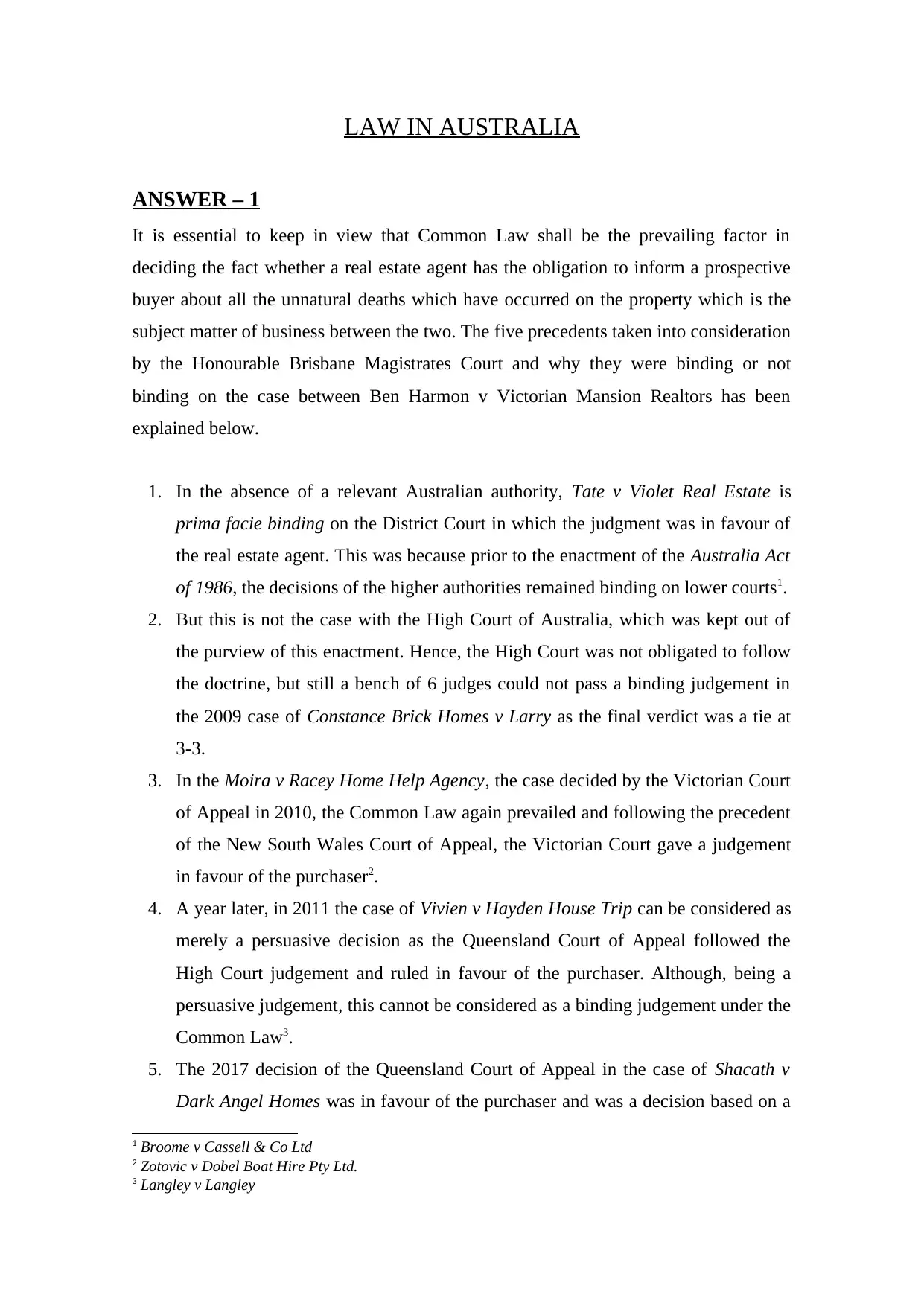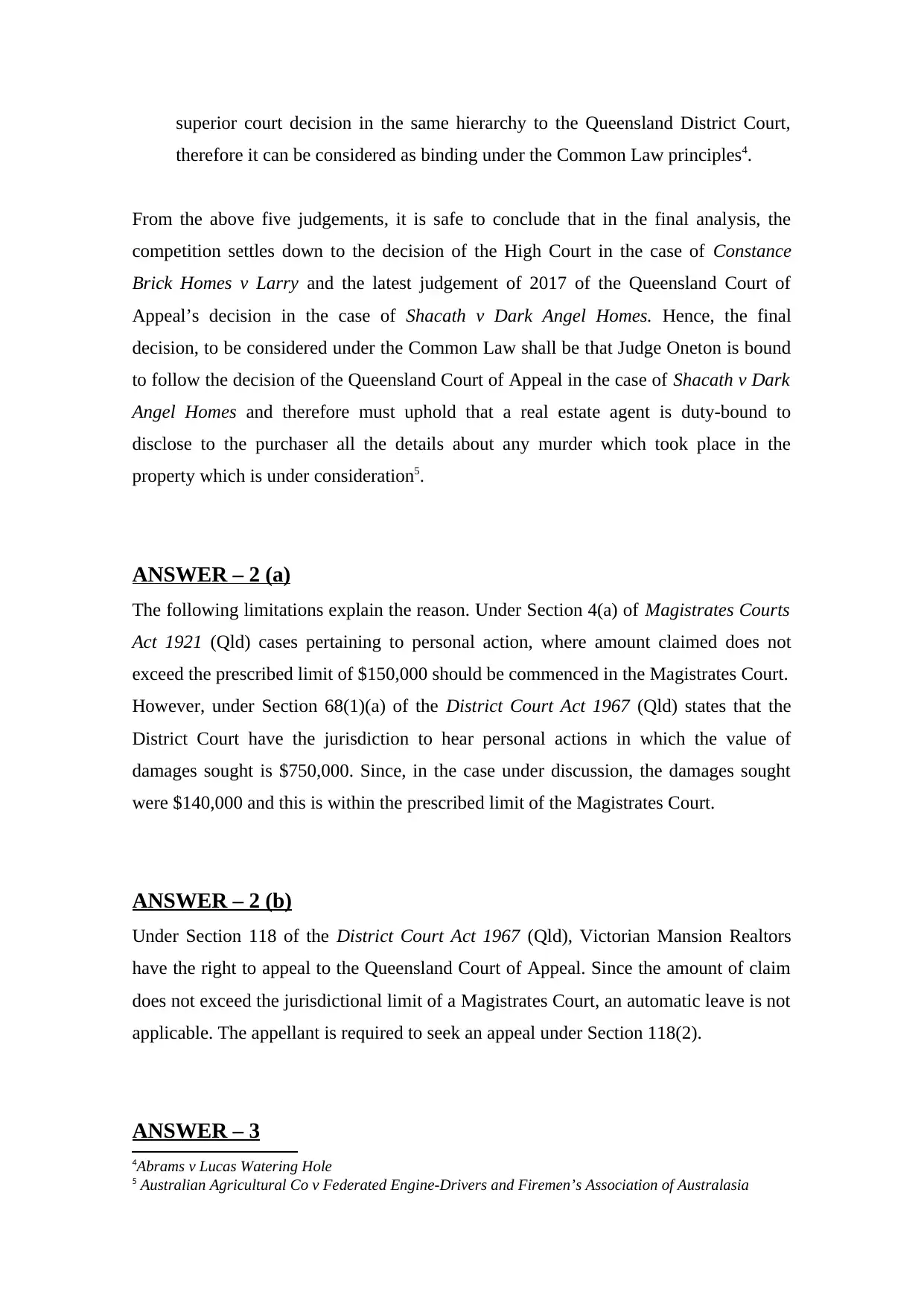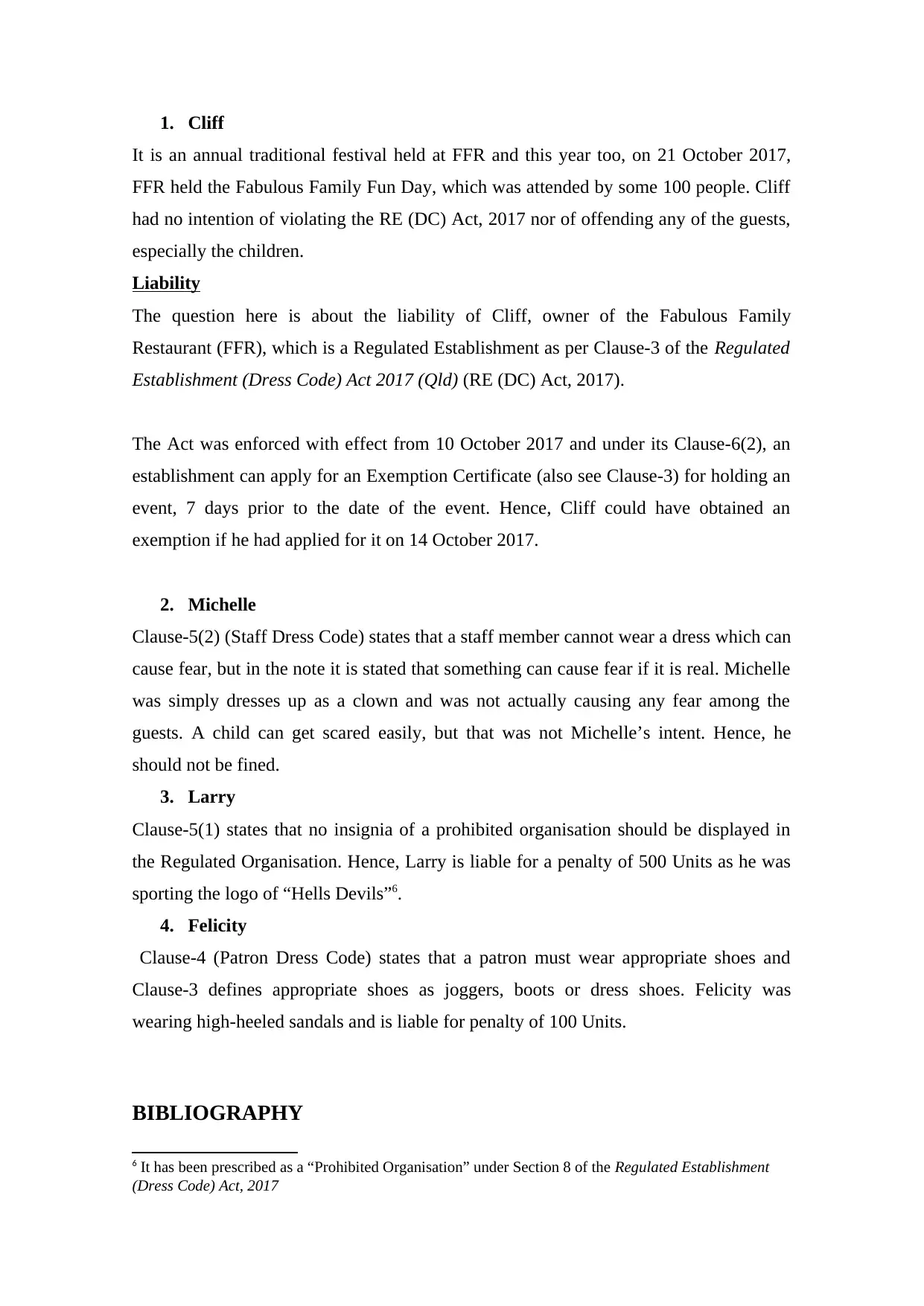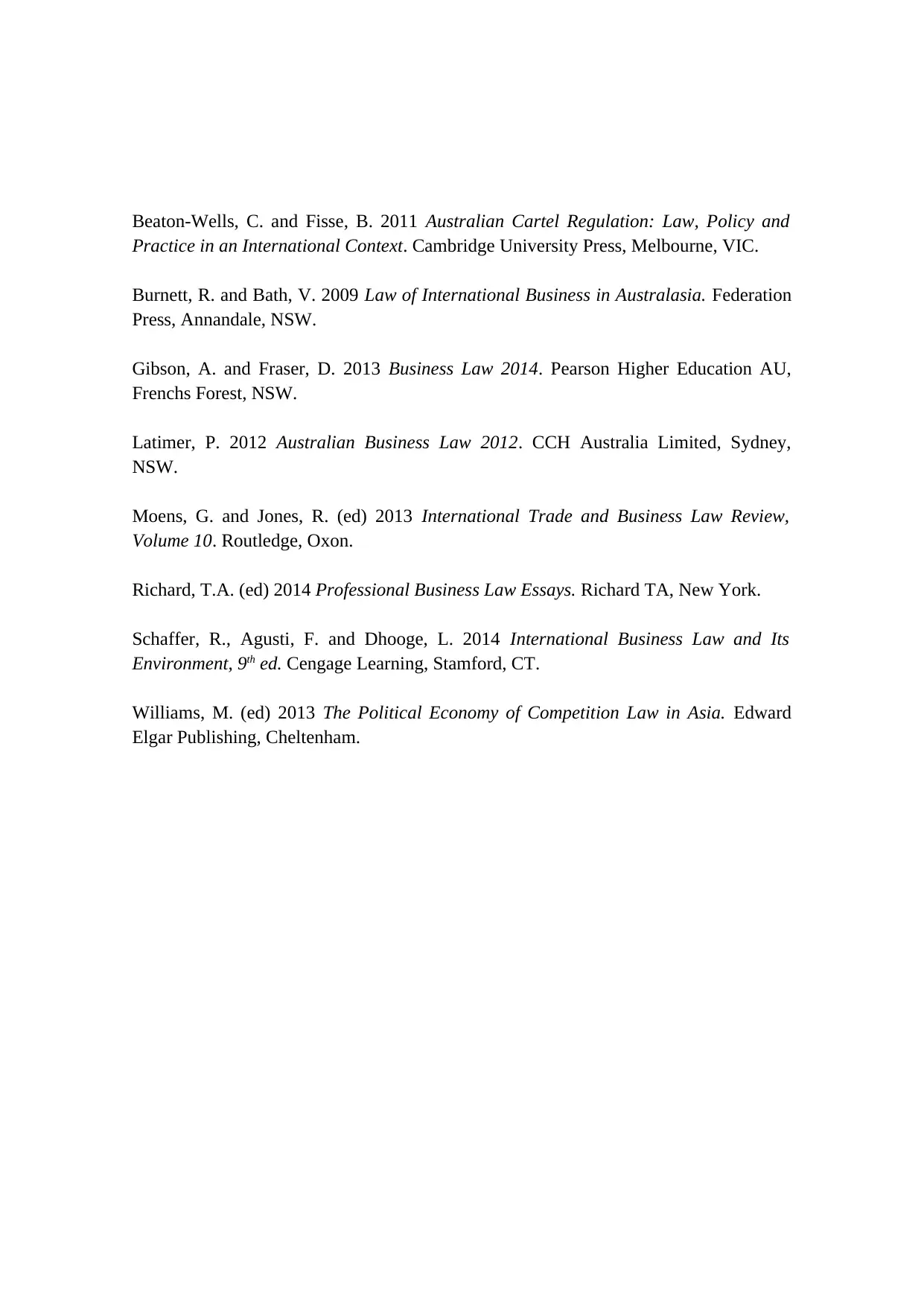Law in Australia: Real Estate, Court Precedents, and Regulations
VerifiedAdded on 2020/04/21
|4
|1264
|79
Homework Assignment
AI Summary
This law assignment solution addresses two primary legal scenarios within the Australian legal framework. The first section analyzes the obligations of a real estate agent to disclose unnatural deaths on a property, examining relevant court precedents, including cases from the Brisbane Magistrates Court, the Victorian Court of Appeal, and the Queensland Court of Appeal, to determine the binding nature of these decisions under Common Law. The second section delves into jurisdictional limitations regarding a case of damages, and the right to appeal, citing the Magistrates Courts Act 1921 (Qld) and the District Court Act 1967 (Qld). Furthermore, the assignment explores the liability of individuals under the Regulated Establishment (Dress Code) Act 2017 (Qld), assessing the responsibilities of the owner of a restaurant and the consequences for staff and patrons regarding dress code violations. The assignment concludes with a comprehensive bibliography of legal resources, providing a foundation for the legal analysis undertaken.

LAW IN AUSTRALIA
ANSWER – 1
It is essential to keep in view that Common Law shall be the prevailing factor in
deciding the fact whether a real estate agent has the obligation to inform a prospective
buyer about all the unnatural deaths which have occurred on the property which is the
subject matter of business between the two. The five precedents taken into consideration
by the Honourable Brisbane Magistrates Court and why they were binding or not
binding on the case between Ben Harmon v Victorian Mansion Realtors has been
explained below.
1. In the absence of a relevant Australian authority, Tate v Violet Real Estate is
prima facie binding on the District Court in which the judgment was in favour of
the real estate agent. This was because prior to the enactment of the Australia Act
of 1986, the decisions of the higher authorities remained binding on lower courts1.
2. But this is not the case with the High Court of Australia, which was kept out of
the purview of this enactment. Hence, the High Court was not obligated to follow
the doctrine, but still a bench of 6 judges could not pass a binding judgement in
the 2009 case of Constance Brick Homes v Larry as the final verdict was a tie at
3-3.
3. In the Moira v Racey Home Help Agency, the case decided by the Victorian Court
of Appeal in 2010, the Common Law again prevailed and following the precedent
of the New South Wales Court of Appeal, the Victorian Court gave a judgement
in favour of the purchaser2.
4. A year later, in 2011 the case of Vivien v Hayden House Trip can be considered as
merely a persuasive decision as the Queensland Court of Appeal followed the
High Court judgement and ruled in favour of the purchaser. Although, being a
persuasive judgement, this cannot be considered as a binding judgement under the
Common Law3.
5. The 2017 decision of the Queensland Court of Appeal in the case of Shacath v
Dark Angel Homes was in favour of the purchaser and was a decision based on a
1 Broome v Cassell & Co Ltd
2 Zotovic v Dobel Boat Hire Pty Ltd.
3 Langley v Langley
ANSWER – 1
It is essential to keep in view that Common Law shall be the prevailing factor in
deciding the fact whether a real estate agent has the obligation to inform a prospective
buyer about all the unnatural deaths which have occurred on the property which is the
subject matter of business between the two. The five precedents taken into consideration
by the Honourable Brisbane Magistrates Court and why they were binding or not
binding on the case between Ben Harmon v Victorian Mansion Realtors has been
explained below.
1. In the absence of a relevant Australian authority, Tate v Violet Real Estate is
prima facie binding on the District Court in which the judgment was in favour of
the real estate agent. This was because prior to the enactment of the Australia Act
of 1986, the decisions of the higher authorities remained binding on lower courts1.
2. But this is not the case with the High Court of Australia, which was kept out of
the purview of this enactment. Hence, the High Court was not obligated to follow
the doctrine, but still a bench of 6 judges could not pass a binding judgement in
the 2009 case of Constance Brick Homes v Larry as the final verdict was a tie at
3-3.
3. In the Moira v Racey Home Help Agency, the case decided by the Victorian Court
of Appeal in 2010, the Common Law again prevailed and following the precedent
of the New South Wales Court of Appeal, the Victorian Court gave a judgement
in favour of the purchaser2.
4. A year later, in 2011 the case of Vivien v Hayden House Trip can be considered as
merely a persuasive decision as the Queensland Court of Appeal followed the
High Court judgement and ruled in favour of the purchaser. Although, being a
persuasive judgement, this cannot be considered as a binding judgement under the
Common Law3.
5. The 2017 decision of the Queensland Court of Appeal in the case of Shacath v
Dark Angel Homes was in favour of the purchaser and was a decision based on a
1 Broome v Cassell & Co Ltd
2 Zotovic v Dobel Boat Hire Pty Ltd.
3 Langley v Langley
Paraphrase This Document
Need a fresh take? Get an instant paraphrase of this document with our AI Paraphraser

superior court decision in the same hierarchy to the Queensland District Court,
therefore it can be considered as binding under the Common Law principles4.
From the above five judgements, it is safe to conclude that in the final analysis, the
competition settles down to the decision of the High Court in the case of Constance
Brick Homes v Larry and the latest judgement of 2017 of the Queensland Court of
Appeal’s decision in the case of Shacath v Dark Angel Homes. Hence, the final
decision, to be considered under the Common Law shall be that Judge Oneton is bound
to follow the decision of the Queensland Court of Appeal in the case of Shacath v Dark
Angel Homes and therefore must uphold that a real estate agent is duty-bound to
disclose to the purchaser all the details about any murder which took place in the
property which is under consideration5.
ANSWER – 2 (a)
The following limitations explain the reason. Under Section 4(a) of Magistrates Courts
Act 1921 (Qld) cases pertaining to personal action, where amount claimed does not
exceed the prescribed limit of $150,000 should be commenced in the Magistrates Court.
However, under Section 68(1)(a) of the District Court Act 1967 (Qld) states that the
District Court have the jurisdiction to hear personal actions in which the value of
damages sought is $750,000. Since, in the case under discussion, the damages sought
were $140,000 and this is within the prescribed limit of the Magistrates Court.
ANSWER – 2 (b)
Under Section 118 of the District Court Act 1967 (Qld), Victorian Mansion Realtors
have the right to appeal to the Queensland Court of Appeal. Since the amount of claim
does not exceed the jurisdictional limit of a Magistrates Court, an automatic leave is not
applicable. The appellant is required to seek an appeal under Section 118(2).
ANSWER – 3
4Abrams v Lucas Watering Hole
5 Australian Agricultural Co v Federated Engine-Drivers and Firemen’s Association of Australasia
therefore it can be considered as binding under the Common Law principles4.
From the above five judgements, it is safe to conclude that in the final analysis, the
competition settles down to the decision of the High Court in the case of Constance
Brick Homes v Larry and the latest judgement of 2017 of the Queensland Court of
Appeal’s decision in the case of Shacath v Dark Angel Homes. Hence, the final
decision, to be considered under the Common Law shall be that Judge Oneton is bound
to follow the decision of the Queensland Court of Appeal in the case of Shacath v Dark
Angel Homes and therefore must uphold that a real estate agent is duty-bound to
disclose to the purchaser all the details about any murder which took place in the
property which is under consideration5.
ANSWER – 2 (a)
The following limitations explain the reason. Under Section 4(a) of Magistrates Courts
Act 1921 (Qld) cases pertaining to personal action, where amount claimed does not
exceed the prescribed limit of $150,000 should be commenced in the Magistrates Court.
However, under Section 68(1)(a) of the District Court Act 1967 (Qld) states that the
District Court have the jurisdiction to hear personal actions in which the value of
damages sought is $750,000. Since, in the case under discussion, the damages sought
were $140,000 and this is within the prescribed limit of the Magistrates Court.
ANSWER – 2 (b)
Under Section 118 of the District Court Act 1967 (Qld), Victorian Mansion Realtors
have the right to appeal to the Queensland Court of Appeal. Since the amount of claim
does not exceed the jurisdictional limit of a Magistrates Court, an automatic leave is not
applicable. The appellant is required to seek an appeal under Section 118(2).
ANSWER – 3
4Abrams v Lucas Watering Hole
5 Australian Agricultural Co v Federated Engine-Drivers and Firemen’s Association of Australasia

1. Cliff
It is an annual traditional festival held at FFR and this year too, on 21 October 2017,
FFR held the Fabulous Family Fun Day, which was attended by some 100 people. Cliff
had no intention of violating the RE (DC) Act, 2017 nor of offending any of the guests,
especially the children.
Liability
The question here is about the liability of Cliff, owner of the Fabulous Family
Restaurant (FFR), which is a Regulated Establishment as per Clause-3 of the Regulated
Establishment (Dress Code) Act 2017 (Qld) (RE (DC) Act, 2017).
The Act was enforced with effect from 10 October 2017 and under its Clause-6(2), an
establishment can apply for an Exemption Certificate (also see Clause-3) for holding an
event, 7 days prior to the date of the event. Hence, Cliff could have obtained an
exemption if he had applied for it on 14 October 2017.
2. Michelle
Clause-5(2) (Staff Dress Code) states that a staff member cannot wear a dress which can
cause fear, but in the note it is stated that something can cause fear if it is real. Michelle
was simply dresses up as a clown and was not actually causing any fear among the
guests. A child can get scared easily, but that was not Michelle’s intent. Hence, he
should not be fined.
3. Larry
Clause-5(1) states that no insignia of a prohibited organisation should be displayed in
the Regulated Organisation. Hence, Larry is liable for a penalty of 500 Units as he was
sporting the logo of “Hells Devils”6.
4. Felicity
Clause-4 (Patron Dress Code) states that a patron must wear appropriate shoes and
Clause-3 defines appropriate shoes as joggers, boots or dress shoes. Felicity was
wearing high-heeled sandals and is liable for penalty of 100 Units.
BIBLIOGRAPHY
6 It has been prescribed as a “Prohibited Organisation” under Section 8 of the Regulated Establishment
(Dress Code) Act, 2017
It is an annual traditional festival held at FFR and this year too, on 21 October 2017,
FFR held the Fabulous Family Fun Day, which was attended by some 100 people. Cliff
had no intention of violating the RE (DC) Act, 2017 nor of offending any of the guests,
especially the children.
Liability
The question here is about the liability of Cliff, owner of the Fabulous Family
Restaurant (FFR), which is a Regulated Establishment as per Clause-3 of the Regulated
Establishment (Dress Code) Act 2017 (Qld) (RE (DC) Act, 2017).
The Act was enforced with effect from 10 October 2017 and under its Clause-6(2), an
establishment can apply for an Exemption Certificate (also see Clause-3) for holding an
event, 7 days prior to the date of the event. Hence, Cliff could have obtained an
exemption if he had applied for it on 14 October 2017.
2. Michelle
Clause-5(2) (Staff Dress Code) states that a staff member cannot wear a dress which can
cause fear, but in the note it is stated that something can cause fear if it is real. Michelle
was simply dresses up as a clown and was not actually causing any fear among the
guests. A child can get scared easily, but that was not Michelle’s intent. Hence, he
should not be fined.
3. Larry
Clause-5(1) states that no insignia of a prohibited organisation should be displayed in
the Regulated Organisation. Hence, Larry is liable for a penalty of 500 Units as he was
sporting the logo of “Hells Devils”6.
4. Felicity
Clause-4 (Patron Dress Code) states that a patron must wear appropriate shoes and
Clause-3 defines appropriate shoes as joggers, boots or dress shoes. Felicity was
wearing high-heeled sandals and is liable for penalty of 100 Units.
BIBLIOGRAPHY
6 It has been prescribed as a “Prohibited Organisation” under Section 8 of the Regulated Establishment
(Dress Code) Act, 2017
⊘ This is a preview!⊘
Do you want full access?
Subscribe today to unlock all pages.

Trusted by 1+ million students worldwide

Beaton-Wells, C. and Fisse, B. 2011 Australian Cartel Regulation: Law, Policy and
Practice in an International Context. Cambridge University Press, Melbourne, VIC.
Burnett, R. and Bath, V. 2009 Law of International Business in Australasia. Federation
Press, Annandale, NSW.
Gibson, A. and Fraser, D. 2013 Business Law 2014. Pearson Higher Education AU,
Frenchs Forest, NSW.
Latimer, P. 2012 Australian Business Law 2012. CCH Australia Limited, Sydney,
NSW.
Moens, G. and Jones, R. (ed) 2013 International Trade and Business Law Review,
Volume 10. Routledge, Oxon.
Richard, T.A. (ed) 2014 Professional Business Law Essays. Richard TA, New York.
Schaffer, R., Agusti, F. and Dhooge, L. 2014 International Business Law and Its
Environment, 9th ed. Cengage Learning, Stamford, CT.
Williams, M. (ed) 2013 The Political Economy of Competition Law in Asia. Edward
Elgar Publishing, Cheltenham.
Practice in an International Context. Cambridge University Press, Melbourne, VIC.
Burnett, R. and Bath, V. 2009 Law of International Business in Australasia. Federation
Press, Annandale, NSW.
Gibson, A. and Fraser, D. 2013 Business Law 2014. Pearson Higher Education AU,
Frenchs Forest, NSW.
Latimer, P. 2012 Australian Business Law 2012. CCH Australia Limited, Sydney,
NSW.
Moens, G. and Jones, R. (ed) 2013 International Trade and Business Law Review,
Volume 10. Routledge, Oxon.
Richard, T.A. (ed) 2014 Professional Business Law Essays. Richard TA, New York.
Schaffer, R., Agusti, F. and Dhooge, L. 2014 International Business Law and Its
Environment, 9th ed. Cengage Learning, Stamford, CT.
Williams, M. (ed) 2013 The Political Economy of Competition Law in Asia. Edward
Elgar Publishing, Cheltenham.
1 out of 4
Your All-in-One AI-Powered Toolkit for Academic Success.
+13062052269
info@desklib.com
Available 24*7 on WhatsApp / Email
![[object Object]](/_next/static/media/star-bottom.7253800d.svg)
Unlock your academic potential
Copyright © 2020–2025 A2Z Services. All Rights Reserved. Developed and managed by ZUCOL.